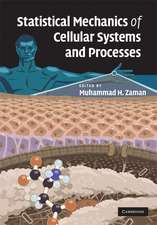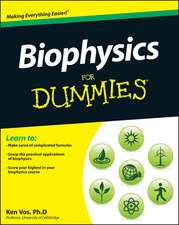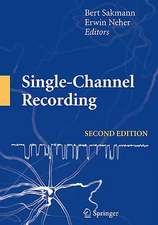The Problem of Excitability: Electrical Excitability and Ionic Permeability of the Nerve Membrane
Autor B. Khodoroven Limba Engleză Paperback – 9 oct 2011
Preț: 387.60 lei
Nou
Puncte Express: 581
Preț estimativ în valută:
74.23€ • 76.48$ • 62.18£
74.23€ • 76.48$ • 62.18£
Carte tipărită la comandă
Livrare economică 25 februarie-11 martie
Preluare comenzi: 021 569.72.76
Specificații
ISBN-13: 9781461344896
ISBN-10: 1461344891
Pagini: 352
Ilustrații: XVIII, 330 p.
Dimensiuni: 152 x 229 x 18 mm
Greutate: 0.47 kg
Ediția:Softcover reprint of the original 1st ed. 1974
Editura: Springer Us
Colecția Springer
Locul publicării:New York, NY, United States
ISBN-10: 1461344891
Pagini: 352
Ilustrații: XVIII, 330 p.
Dimensiuni: 152 x 229 x 18 mm
Greutate: 0.47 kg
Ediția:Softcover reprint of the original 1st ed. 1974
Editura: Springer Us
Colecția Springer
Locul publicării:New York, NY, United States
Public țintă
ResearchCuprins
I. Excitability and Relationships Between the Initial and Critical Values of the Membrane Potential.- Changes in Vt associated with primary shifts of Er.- Changes in Vt resulting from a primary shift of Ec.- II. The Resting Potential.- III. Passive and Subthreshold Active Changes in the Membrane Potential.- Passive changes of membrane potential.- The local response.- IV. The Action Potential.- Historical.- Effect of changes in external and internal sodium and potassium ion concentrations on action potential generation.- Movement of ions through the membrane during activity.- Evidence for subdivision of the ionic currents.- Changes in ionic permeability.- Quantitative description of ionic currents.- V. Dependence of Action Potential Parameters on the Constants of Membrane Ionic Permeability.- Maximal sodium permeability $$\rm \overline P _{Na} $$Na.- Steady-state sodium inactivation (1 - h?) and time constant Th.- Reactivity of the sodium system (sensitivity of PNa to changes in membrane potential).- The threshold potential.- Maximal steepness of rise of the ascending phase of the action potential.- Amplitude of the action potential.- Duration of the action potential.- Time constant of sodium activation Tm.- Maximal potassium permeability $$\rm \overline P _K $$.- Reactivity of the potassium system (sensitivity of $$\rm \overline P _K $$ to changes in membrane potential).- Effects of an increase in reactivity of thepotassium system.- Effects of a decrease in reactivity of the potassium activating system.- Time constant of potassium activation (Tn).- Assessment of the character of changes in ionic permeability of the membrane from changes in the action potential.- VI. Analysis of Threshold Conditions of Stimulation and the Relationship Between the Threshold Current andThreshold Potential.- The strength versus duration curve.- Character of critical depolarization of the membrane during the action of pulses of current of different duration. Nature of the utilization time.- Relationship between the threshold current and the passive and active properties of the membrane.- VII. Role of the Rate of Change of the Stimulus. The Phenomenon of Accommodation.- The accommodation curve.- The mechanism of accommodation.- Minimal gradient as a function of the constants of ionic permeability of the membrane.- Accommodation and repetitive responses.- VIII. Cable Properties and Geometry of Excitable Structures and Parameters of Their Electrical Activity.- The propagated action potential.- Threshold conditions of stimulation.- The threshold potential.- The threshold current.- The strength versus duration curve.- Repetitive responses in a continuous axon.- Effects of stimulation of excitable structures with a functionally nonuniform membrane.- The relationship between the velocity of conductance of the action potential and the cable properties and excitability of the fiber.- Conduction of impulses along a nonuniform fiber.- Some properties of spike conduction from a medullated into a nonmedullated segment of a nerve fiber.- Compensatory changes in ionic currents during conduction of the impulse along a nonuniform fiber.- IX. Molecular Mechanisms of Ionic Permeability of the Excitable Membrane.- Functional architecture of the excitable membrane.- The hypothesis of ionic carriers.- The hypothesis of ion pores.- Hypotheses on conformational changes in the membrane.- Investigations of mechanisms of the changes in ionic permeability on artificial membranes.- Precipitation membranes.- Phospholipid membranes.- Conclusion.- Addendum.












